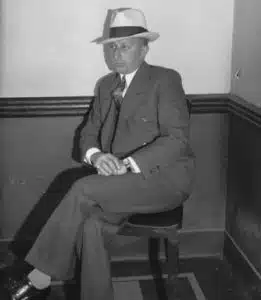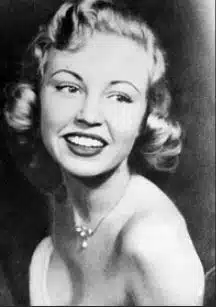The Rise and Fall of Little Augie Pisano: Unveiling the Unfold Chronicles of Organized Crime

In the shadowy annals of organized crime during the mid-20th century, the name Anthony Carfano, or “Little Augie Pisano,” looms large as a symbol of power, ambition, and the tumultuous underbelly of the Luciano crime family. This comprehensive exploration seeks to delve even deeper into the enigmatic life of Little Augie, unraveling the intricate threads that led to his rise within the criminal hierarchy and the complex circumstances surrounding his mysterious demise, particularly on the fateful night of September 25, 1959.
Early Life:
Born in November 1895 on Oliver Street in Manhattan, Anthony Carfano’s roots traced back to Giovanni Carfagno and Dongetta Visocchi, immigrants from Naples, Italy. Growing up in an environment teeming with Italian-American culture, Carfano’s early experiences would lay the foundation for his eventual immersion into the world of organized crime.
Criminal Ascension:
Carfano’s initiation into the criminal underworld began in the early 1920s as a lowly gunman for the notorious Frankie Yale, operating in Yale’s south Brooklyn empire. As alliances shifted, Carfano found himself taking charge after Yale’s assassination in 1928, becoming a caporegime under the formidable Joe Masseria. His ascent through the ranks marked the beginning of a journey that would see him play a pivotal role in the organized crime landscape of the time.
Miami’s Wofford Hotel:
One of Carfano’s crowning achievements was his leadership in the late 1930s, guiding Luciano crime family operations in South Florida. His strategic acumen and criminal expertise allowed him to organize widespread gambling operations and establish legitimate businesses, with the opulent Wofford Hotel in Miami standing as a testament to his success.
Controversial Alliances:
Carfano’s prowess in South Florida faced a critical juncture when Meyer Lansky proposed the notion of declaring Miami and Miami Beach “open cities” for any crime family. Despite initial objections, Carfano eventually cooperated, leading to the establishment of a sprawling, multi-million dollar gambling empire in the region. This collaboration, however, would later introduce complexities into his criminal career.
Power Struggles:
The late 1950s brought about a power struggle within the Luciano crime family, with Vito Genovese vying for control. Carfano’s unwavering loyalty to Frank Costello, who had taken over after Charles “Lucky” Luciano’s imprisonment in 1936, led to tensions with the emerging leadership. Despite Costello’s stepping down, Carfano adamantly refused to acknowledge Genovese as the new head of the family, setting the stage for a conflict that would prove fatal.
September 25, 1959 – The Fateful Night:
On the night of September 25, 1959, Anthony Carfano’s fate took a dark turn. Leaving Marino’s restaurant with Janice Drake, a mysterious phone call altered their plans, diverting them to a dimly lit street near LaGuardia Airport. The events that unfolded in the next hours would seal their destinies. Gunfire erupted, claiming the lives of Carfano and Drake and leaving a trail of unanswered questions that continue to baffle investigators to this day.
Details of the Assassination:
As Carfano and Janice Drake left Marino’s restaurant, believing they were heading to LaGuardia Airport for a flight to Miami, a mysterious phone call changed their course. Shortly afterward, the couple encountered a friend in the restroom, a jeweler who agreed to retrieve Carfano’s car from The Copacabana, a short walk away. Little did they know that this would be the last friendly interaction before the impending tragedy.
The Killers Await:
The murderers, allegedly waiting for Carfano, positioned themselves about a twenty-minute drive away, near LaGuardia Field Airport. The precise destination was The Travellers Rest Hotel, where Carfano parked his Cadillac on the corner of Ditmars Avenue and 94th Street. As he and Janice entered the hotel’s cocktail bar, they engaged in conversation with two well-dressed individuals described as “smart, well-dressed, business types.”
A Chilling Encounter:
Around 10:20 pm, the quartet left the hotel, with Carfano behind the wheel of his Cadillac, heading south down 94th Street. Just half a mile from the airport, near the cross-street at 25th Avenue, the Cadillac slowed for an inexplicable reason. A barrage of shots erupted, casting an eerie light into the car’s interior. The vehicle juddered to a halt, its nearside front wheel mounting the curb outside 24-50, a two-story apartment house.
Response and Investigation:
Residents in the vicinity were immediately alarmed by the gunshots, prompting a flurry of phone calls to the police. Patrolmen Charles Simmons and William Woods were the first officers on the scene around 10:40 pm, reporting that the car’s engine was running, and its headlights were on. By 11:00 pm, at least fifteen squad cars had responded, cordoning off the street and the avenue. Despite the swift response, the murders of Anthony Carfano and Janice Drake remained unsolved.
Legacy:
The shadowy legacy of Anthony Carfano endures, encapsulating the complexity and danger inherent in the world of organized crime during the mid-20th century. His rise and fall stand as a testament to the perilous alliances, power struggles, and treacherous paths within this clandestine realm. As we untangle the web of his life, the tale of Little Augie Pisano unfolds as a cautionary narrative, providing a unique lens into the ever-shifting dynamics of organized crime.
Conclusion:
Anthony Carfano’s journey from a New York hoodlum to a key player in the Luciano crime family is a sprawling saga filled with intrigue and peril. His life, marked by alliances, conflicts, and a mysterious demise, adds another layer to the complex tapestry of organized crime in mid-20th century America. The unanswered questions surrounding his assassination only deepen the mystique surrounding this enigmatic figure in mob history. In the shadows of his legacy, the tale of Little Augie Pisano resonates as a cautionary narrative of the perils inherent in the pursuit of power within the clandestine world of organized crime, inviting us to explore further the untold stories and secrets that lie beneath the surface.



